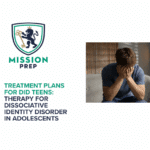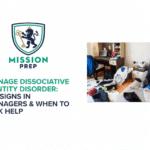DID Co-Occurring Disorders in Teens: Mental Health Conditions Linked to Dissociative Identity Disorder

Dissociative identity disorder (DID) is one of the most complex and misunderstood mental health diagnoses, especially in adolescents. While there’s already a lot of misinformation about and inaccurate portrayals of DID in circulation in the media, there’s another issue that can make the condition even more complicated – comorbidity.
Unfortunately, DID rarely occurs alone. People with DID often also struggle with co-occurring disorders, such as anxiety, depression, or PTSD. These co-occurring disorders in teens can make diagnosis convoluted, potentially delaying access to effective treatments.
If you think your teen may be experiencing one or more mental health difficulties, consulting a mental health professional is always recommended. However, understanding potential DID co-occurring disorders teens may have can also be a crucial step for parents wanting to support their teen’s mental health recovery.
This page can help you better understand DID co-occurring disorders in teens by exploring:
- What dissociative identity disorder is
- Why DID often co-occurs with other conditions
- Common co-occurring disorders linked to teen DID
- Treatment options for teens with DID
- Where to find professional support

What Is Dissociative Identity Disorder in Teens?
Dissociative identity disorder (DID) is a complex mental health condition in which a teen experiences two or more distinct personalities or identities. These distinct identities are commonly referred to as “alters,” and can function independently of each other. Therefore, they may each have unique behaviors and memories.
DID is often caused by childhood trauma, including abuse or neglect, with 90% of people with DID having experienced early childhood trauma over a prolonged period of time.1,2 Also, DID may develop if someone’s childhood home was a frightening environment, such as in cases of disorganized attachment or living in areas of war.3,4 Furthermore, research shows that the most severe cases of DID are frequently connected to experiencing very early, chronic abuse, often from a parent or main caregiver.5
In response to childhood trauma, a child’s mind may develop a survival strategy of dissociation, a way of removing themselves mentally from a scary situation that they cannot physically escape. While dissociation can be temporarily beneficial, if it’s required for a long period of time, it can persist into adolescence and adulthood – potentially becoming DID.
If your teen has DID, some examples of behavior they may exhibit include:
- Sudden changes in mood or behavior
- Seeming like a different person in terms of how they speak or what they enjoy doing
- Memory gaps or losing time
- Feeling disconnected from themselves, their surroundings, or reality
- Experiencing inner conflict
You can find more details and examples of DID symptoms in our guide, DID Signs in Teenagers.
It’s important to remember that although symptoms may appear confusing or frightening, DID is a treatable mental health condition.
Why Co-occurring Disorders in Teens Are Common With DID
As mentioned, DID is a complex condition that, in many cases, doesn’t occur on its own. When DID is present along with other serious mental health concerns, this is sometimes referred to as “teenage DID and comorbid disorders.”
Like with other mental health conditions, co-morbidity in DID can happen because the main cause of DID is also a risk factor for other mental health conditions.6 In other words, co-occurring disorders in teens are often linked to the same unresolved trauma that DID developed from.
If an adolescent is living with multiple mental health challenges, any treatment care plan should include a coordinated and trauma-informed approach to effectively treat each condition. Otherwise, if only one condition is treated, the teen likely will not fully recover, as the other issues have not been addressed.
Therefore, it is important that co-occurring disorders treatment DID teens receive targets both dissociative symptoms from the DID and any issues created by other related mental health issues. If this comprehensive type of care is implemented, a teen faces the best chance at recovery.
Additionally, supporting dual diagnosis DID youth with early interventions can make a significant difference to their outcomes. To do so, it can be useful to know the most common mental health conditions that occur alongside DID. We explore these conditions in the following section.
Common Mental Health Conditions Linked to DID in Teens
As clarified, teens with DID often struggle with co-occurring mental health conditions. Aside from the complex array of symptoms comorbid disorders can create, they may also make it
difficult to obtain an accurate diagnosis and access the right treatment and support.
Therefore, awareness of the common co-occurring disorders of teenage DID is often vital for understanding the most suitable forms of help, support, and treatment that your child may require.
The following conditions are frequently linked to DID in adolescents:
PTSD Co-Occurring With DID Youth
Post-traumatic stress disorder isn’t something that only war veterans develop; anyone can develop it after witnessing or experiencing something traumatic. Plus, given that DID and PTSD both have their roots in trauma, it’s perhaps unsurprising that these are commonly co-occurring conditions in teens. In fact, according to recent studies, up to 89% of people with DID also have PTSD.7 Additionally, there is a subtype of PTSD called “dissociative PTSD,” in which a person experiences symptoms of “typical” PTSD along with feelings of depersonalization or derealization.8 The latter issues are also symptoms of DID.
Mood Disorders
According to research, mood disorders are the second-most commonly co-occurring disorders in teens with DID, as up to 83% of people with DID experience them.7 Mood disorders encompass conditions such as depression and bipolar disorder.
Depression often involves feelings of hopelessness, fatigue, and emotional numbness. When it comes to depression and DID teenagers, these feelings could be tied to unresolved early childhood trauma or may result from the internal conflict and confusion caused by dissociation. However, the problem with depression diagnosis is that some alters in DID may carry depressive symptoms while others may not.9
Identifying bipolar disorder when DID is present can also be challenging due to overlapping symptoms. For example, bipolar disorder involves episodes of both depression and mania, and can feel like a rollercoaster of highs and lows. Therefore, relatively sudden mood shifts are symptoms that both teens with bipolar disorder and DID teenagers share. Furthermore, people with bipolar disorder may sometimes experience dissociative symptoms, such as memory gaps or feeling detached from reality.
Borderline Personality Disorder (BPD)
BPD is a condition that between 30% and 70% of people with DID live with. BPD often begins during adolescence or early adulthood, and is a serious mental illness that typically leaves someone unable to effectively manage their emotions. It can also result in identity confusion, extreme mood changes, and difficulty managing relationships with others.10 As you may remember from earlier, sudden mood changes and identity confusion are some of the core behaviors that teenagers with DID also exhibit. Therefore, being able to accurately diagnose these conditions independently can be complicated at times due to symptom overlap, but it is essential for obtaining the right support for your child.
Anxiety and DID Teens
Anxiety disorders are highly common, affecting almost a third of U.S. teenagers.11 However, anxiety disorders are even more common in teens with DID, affecting up to 50% of people with DID.7 Anxiety is often a stress response, so varying stressful situations could potentially lead to different alters being triggered. Studies even suggest that being anxiety-sensitive is linked with symptom severity in dissociative identity disorder, highlighting the importance of treating anxiety disorders to potentially alleviate dissociative episodes.12
Eating Disorders
It’s not always recognized, but disordered eating can be a way for some people to regulate their emotions. Often, people who have survived traumatic experiences have difficulty regulating their emotions, so eating disorders may develop as a way to cope.6 Additionally, trauma, dissociation, and dissociative disorders have long been linked to eating disorders. In fact, nearly 30% of people with DID also have a co-occurring eating disorder.7,13
When it comes to eating disorders DID teens may struggle with several issues, such as different identities having conflicting views about food or body image. This could result in binges, restrictions, or purges that teens may not even be aware of. In cases of eating disorders co-occurring with DID, personalized, trauma-informed care and collaboration with nutritional therapy experts is required.
As may be evident, mental health conditions linked to DID adolescents may make diagnosis and treatment more complex. Some co-occurring disorders in teens may also be the direct result of childhood trauma, while others may contribute to the severity of DID symptoms.
Additionally, other conditions may share enough similarities with DID symptoms that picking apart the presenting signs of two separate conditions could be difficult. However, it is essential to gain an accurate and full diagnosis of each mental health condition your teen may have so that they can receive the correct treatment.
Therapy for DID With Other Mental Health Conditions
When a teen is living with DID and co-occurring mental health conditions, the treatment may become highly specialized.
Whereas standard therapy models often focus on treating a single diagnosis, effective treatment for DID and co-occurring disorders in teens typically requires an integrated approach. The integrated care DID adolescents require calls for a collaborative model of care across the various providers involved, including the teen and their family. For example, this approach may require multiple forms of therapy, medication management, and other support services.
Additionally, this collaborative approach will likely involve a skilled therapist trained in several different modalities. Some of the most effective therapies for teens with DID and co-occurring disorders include:
- Trauma-focused therapy: This approach uses a combination of techniques to help someone process their traumatic experiences, develop coping skills, and address any trauma-related symptoms. Sessions often involve discussing traumatic memories in a safe and supportive environment. However, there are some trauma-focused therapies, such as eye movement desensitization and reprocessing (EMDR), that allow patients to process trauma and fragmented memories without needing to discuss all details.14
- Dialectical behavior therapy (DBT): DBT teaches teenagers the skills needed to build emotional regulation and stability. It can also help them to improve their communication and enable them to better manage distress.15
- Cognitive behavioral therapy (CBT): CBT allows adolescents to learn more about their condition and develop a greater self-awareness of their thoughts, feelings, and behaviors, as well as the link between the three. They may also discover healthy coping strategies and be given homework to encourage them to practice their new skills at home.
All of the above are therapy options that can take place on an outpatient basis. However, for teens experiencing complex symptoms, residential treatment may be more appropriate for their needs.
Benefits of Residential Treatment for Co-Occurring Disorder With DID
In cases where outpatient therapy isn’t bringing the improvements hoped for, or if your teen poses a risk to themselves, residential treatment may be a beneficial option.
In residential programs co-occurring DID teens can receive 24/7 care and support from a range of medical and mental health professionals. In addition to meeting their therapy needs, residential settings can provide many opportunities for teens. For example, education to understand their condition better, the chance to learn new skills, and access to peer support from others with conditions similar to their own. In a nutshell, residential programs offer a safe and supportive environment where teens can make recovery their sole focus.

Helping Your Teen Heal With Mission Prep
Navigating the complexities of dissociative identity disorder and co-occurring disorders in teens can feel overwhelming, both for the teen and their entire family. But you don’t have to navigate this journey alone. With the right professional support, teens struggling with DID and other mental health conditions can heal and grow.
At Mission Prep, we specialize in supporting teens through their mental health challenges. Using trauma-informed, evidence-based therapies, we take a personalized and integrated approach to providing care. Our compassionate team of mental health professionals understands the challenges that people with DID face and is here to help you and your family every step of the way.
If you’re concerned about your teen’s well-being, reach out to us today to discover how we can help your child begin their recovery journey.
References
- Şar, V. (2014). The Many Faces of Dissociation: Opportunities for Innovative research in Psychiatry. Clinical Psychopharmacology and Neuroscience, 12(3), 171–179. https://doi.org/10.9758/cpn.2014.12.3.171
- Bistas, K., & Grewal, R. (2024). Unraveling the layers: Dissociative identity disorder as a response to trauma. Cureus. https://doi.org/10.7759/cureus.60676
- Mitra, P., & Jain, A. (2023, May 16). Dissociative Identity Disorder. StatPearls – NCBI Bookshelf. https://www.ncbi.nlm.nih.gov/books/NBK568768/
- Mayo Clinic. (n.d.). Dissociative disorders – Symptoms and causes. Retrieved September 16, 2025, from https://www.mayoclinic.org/diseases-conditions/dissociative-disorders/symptoms-causes/syc-20355215
- Sar, V., Dorahy, M., & Krüger, C. (2017). Revisiting the etiological aspects of dissociative identity disorder: a biopsychosocial perspective. Psychology Research and Behavior Management, Volume 10, 137–146. https://doi.org/10.2147/prbm.s113743
- Substance Abuse and Mental Health Services Administration (2014). Understanding the impact of trauma. Trauma-Informed Care in Behavioral Health Services – NCBI Bookshelf. https://www.ncbi.nlm.nih.gov/books/NBK207191/
- Brand, B. L., & Lanius, R. A. (2014). Chronic complex dissociative disorders and borderline personality disorder: disorders of emotion dysregulation? Borderline Personality Disorder and Emotion Dysregulation, 1(1), 13. https://doi.org/10.1186/2051-6673-1-13
- Tull, M. (2023, February 1). Understanding PTSD and dissociation. Verywell Mind. https://www.verywellmind.com/how-trauma-can-lead-to-dissociative-disorders-2797534
- Pistoia, J. (2023, May 9). What is Bipolar Dissociation? Healthline. https://www.healthline.com/health/bipolar/bipolar-dissociation
- Chapman, J., Jamil, R. T., Fleisher, C., & Torrico, T. J. (2025). Borderline personality disorder. In StatPearls. StatPearls Publishing. https://www.ncbi.nlm.nih.gov/books/NBK430883/
- Anxiety and Depression Association of America, ADAA. (2025, August 21). Facts & Statistics. https://adaa.org/understanding-anxiety/facts-statistics
- Pan, X., Palermo, C. A., Kaplan, C. S., Harnett, N. G., Winternitz, S. R., Kaufman, M. L., & Lebois, L. a. M. (2022). Anxiety sensitivity predicts depression severity in individuals with dissociative identity disorder. Journal of Psychiatric Research, 155, 263–268. https://doi.org/10.1016/j.jpsychires.2022.09.003
- Brewerton, T. D., Perlman, M. M., Gavidia, I., & Suro, G. (2023). The treatment of dissociative identity disorder in an eating disorder residential treatment setting. International Journal of Eating Disorders, 57(2), 450–457. https://doi.org/10.1002/eat.24106
- Twombly, J. H. (2000). Incorporating EMDR and EMDR Adaptations into the Treatment of Clients with Dissociative Identity Disorder. Journal of Trauma & Dissociation, 1(2), 61–81. https://doi.org/10.1300/j229v01n02_05
- Foote, B., & Van Orden, K. (2016). Adapting Dialectical Behavior therapy for the treatment of dissociative identity Disorder. American Journal of Psychotherapy, 70(4), 343–364. https://doi.org/10.1176/appi.psychotherapy.2016.70.4.343

















